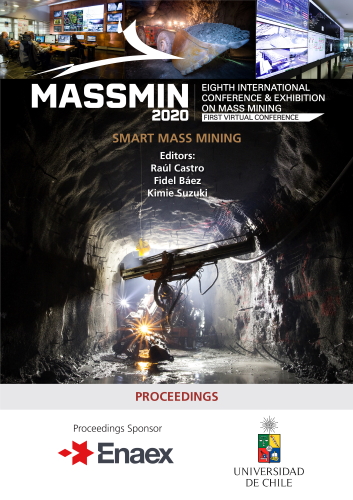Observational rock mass damage model associated to caving advance of Chuquicamata Underground Mine

|
Authors: Constanzo, HE; Guerra, PC; Barindelli, GA |
This paper is hosted with the kind permission of Lulea University of Technology, International Conference & Exhibition on Mass Mining, 2024.
DOI https://doi.org/10.36487/ACG_repo/2063_65
Cite As:
Constanzo, HE, Guerra, PC & Barindelli, GA 2020, 'Observational rock mass damage model associated to caving advance of Chuquicamata Underground Mine', in R Castro, F Báez & K Suzuki (eds), MassMin 2020: Proceedings of the Eighth International Conference & Exhibition on Mass Mining, University of Chile, Santiago, pp. 910-921, https://doi.org/10.36487/ACG_repo/2063_65
Abstract:
The Chuquicamata Underground Mine (ChUM) plans to reach a production regime of 140,000 tons per day (tpd). The seven-year ramp-up established to achieve this represents a major challenge. The Chuquicamata Underground Mine uses the block caving method, characterized by a dynamic caving front that constantly modifies the stress condition of the rock mass which reflects damage to the production sector’s drifts. It also uses a combination of preconditioning by hydraulic fracturing and confined blasting, referred to as intensive preconditioning (Catalan et al. 2017). By identifying the variables that impact the behavior of the rock mass damage caused by the mining advance, it is possible to obtain an observational model for use in evaluations that minimize bias because the variables impacting the damage are clearly identified and the model’s application in the mine (undercut and production level drifts) requires low-complexity training. Use of the observational model to assess rock mass damage associated with the caving progression in the Chuquicamata Underground Mine permits evaluation of its behavior prior to mining activity and the application of different exploitation strategies, using unbiased information. This is related to the physical parameters that govern the caving behavior and permits the subsequent calibration of numerical models.
References:
Catalan, A, Onederra, I, & Chitombo, G 2017, ‘Evaluation of intensive preconditioning in block and panel caving–part II, quantifying the effect on seismicity and draw rates’, Transactions of the Institutions of Mining and Metallurgy, Section A: Mining Technology, vol. 126, no. 4, pp. 221-239.
Constanzo, HB & Parraguez, RR 2001, ‘Utilización de un modelo de daño en el macizo rocoso como herramienta de apoyo en los diseños Geomecánico de la mina El Teniente’, Simposium de Ingeniería en Minas. 2° Edición SIMIN II, in Spanish.
Constanzo, HB, Guerra, LV, Moreno, LT & Osses, AM 1998, ‘Metodología Práctica para Evaluación cualitativa del Daño al Macizo Rocoso, Fortificación y Puntos de Extracción según Actividad Minera Caso: Área Invariante de Tte-Sub6’, Informe Técnico PL-I-045-98. Superintendencia General Planificación MINCO, División El Teniente- CODELCO Chile, in Spanish.
Flores, G, & Catalan, A 2019, ‘A transition from a large open pit into a novel “macroblock variant” block caving geometry at Chuquicamata mine, CODELCO-Chile’, Journal of Rock Mechanics and Geotechnical Engineering, vol. 11, no. 3, pp. 549-561.
GRMD - CODELCO 2019a, ‘Plano De Estado Macizo Rocoso Nivel Hundimiento Y Producción’, División Chuquicamata, Gerencia de Recursos Mineros y Desarrollo, CODELCO, Nota técnica, GRMD–SPM–081–2019, [September 2019], in Spanish.
GRMD - CODELCO 2019b, ‘Plano De Estado Macizo Rocoso Nivel Hundimiento Y Producción N1 y S1’, División Chuquicamata, Gerencia de Recursos Mineros y Desarrollo, Nota técnica, CODELCO, GRMD–SPM–119–2019, [19 December 2019], in Spanish.
Hoek, E 2001, Rock mass properties for underground mines, Underground Mining Methods: Engineering Fundamentals and International Case Studies, Littleton, Colorado.
Palmström, A, & Strömme, B 1996, ‘The Rock Mass index (RMÐ applied in rock mechanics and rock engineering’, Journal of Rock Mechanics and Tunnelling Technology, vol. 11, no. 2, pp. 1-40.
© Copyright 2025, Australian Centre for Geomechanics (ACG), The University of Western Australia. All rights reserved.
View copyright/legal information
Please direct any queries or error reports to repository-acg@uwa.edu.au
View copyright/legal information
Please direct any queries or error reports to repository-acg@uwa.edu.au
